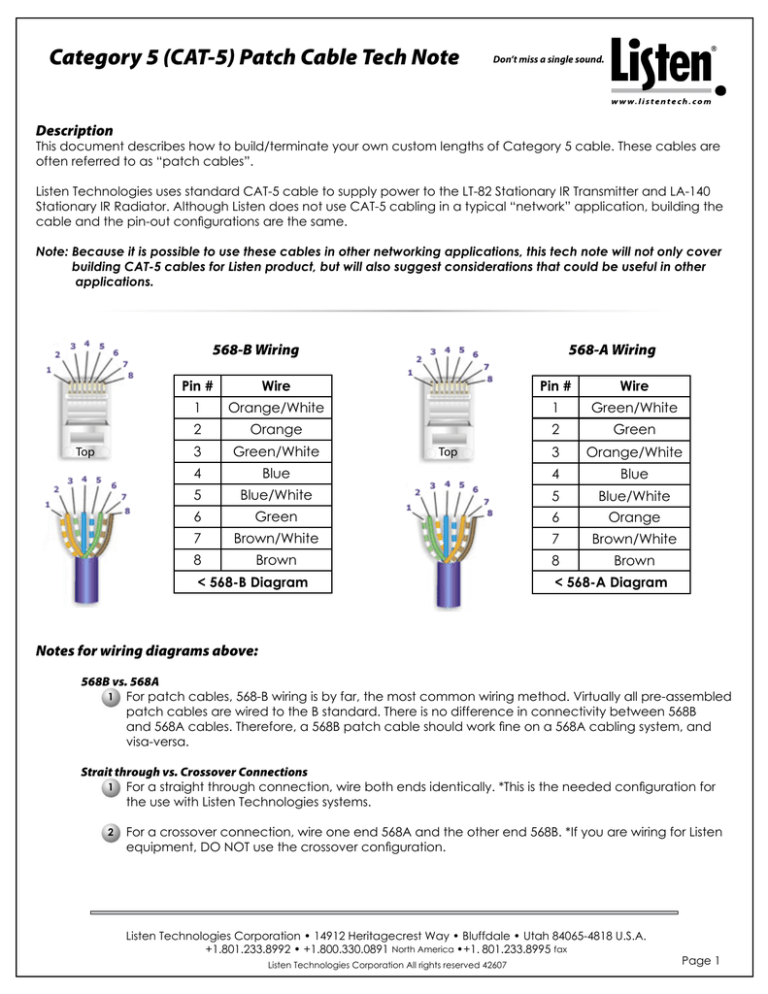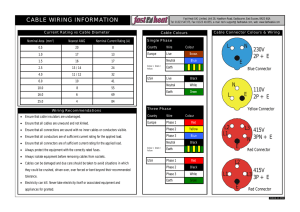
Category 5 (CAT-5) Patch Cable Tech Note
Don’t miss a single sound.
Description
This document describes how to build/terminate your own custom lengths of Category 5 cable. These cables are
often referred to as “patch cables”.
Listen Technologies uses standard CAT-5 cable to supply power to the LT-82 Stationary IR Transmitter and LA-140
Stationary IR Radiator. Although Listen does not use CAT-5 cabling in a typical “network” application, building the
cable and the pin-out configurations are the same.
Note: B
ecause it is possible to use these cables in other networking applications, this tech note will not only cover
building CAT-5 cables for Listen product, but will also suggest considerations that could be useful in other
applications.
568-B Wiring
Top
568-A Wiring
Pin #
Wire
Pin #
Wire
1
Orange/White
1
Green/White
2
Orange
2
Green
3
Green/White
3
Orange/White
4
Blue
4
Blue
5
Blue/White
5
Blue/White
6
Green
6
Orange
7
Brown/White
7
Brown/White
8
Brown
8
Brown
Top
< 568-B Diagram
< 568-A Diagram
Notes for wiring diagrams above:
568B vs. 568A
1 For patch cables, 568-B wiring is by far, the most common wiring method. Virtually all pre-assembled
patch cables are wired to the B standard. There is no difference in connectivity between 568B
and 568A cables. Therefore, a 568B patch cable should work fine on a 568A cabling system, and
visa-versa.
Strait through vs. Crossover Connections
1
For
a straight through connection, wire both ends identically. *This is the needed configuration for
the use with Listen Technologies systems.
2 For a crossover connection, wire one end 568A and the other end 568B. *If you are wiring for Listen
equipment, DO NOT use the crossover configuration.
Listen Technologies Corporation • 14912 Heritagecrest Way • Bluffdale • Utah 84065-4818 U.S.A.
+1.801.233.8992 • +1.800.330.0891 North America •+1. 801.233.8995 fax
Listen Technologies Corporation All rights reserved 42607
Page Category 5 (CAT-5) Patch Cable Tech Note
Don’t miss a single sound.
Needed Materials:
CAT-5 Cable (LA-70)
RJ-45 Connectors (LA-71)
Wire Strippers
CAT-5 Crimp Tool
Scissors (optional)
CAT-5 Cable Tester (optional)
Patch Cable Assembly Instructions
1 Skin off the cable jacket approximately 1 in. (25 mm) or slightly more.
2 Untwist each pair, and straighten each wire between the fingers.
3 Place the wires in the order of the diagram chosen from above (568B or 568A). Bring all
of the wires together, until they touch.
4 Double check the wiring sequence with the diagram for good measure.
Optional: M
ake a mark on the wires at 0.5 in. (13 mm) from the end of the cable jacket.
5
Hold the grouped (and sorted) wires together tightly between your thumb and forefinger.
6 Cut all of the wires at a perfect 90° angle to the cable 0.5 in. (13 mm) from the end of the
cable jacket. This is a very critical step. If the wires are not cut straight, they may not all
make contact. It is recommended to use a pair of scissors for this purpose.
7 Insert the wires into the RJ-45 connector (LA-71). The pins should be facing up*.
* See diagram on page 1.
8 Push moderately hard to assure that all of the wires have reached the end of the RJ-45
connector (LA-71). Be sure that the cable jacket goes into the back of the connector by
about 0.19 in. (5 mm).
9 Visually inspect the connector and verify that all of the wires have been completely
inserted to the end of the connector.
10 Place the connector into a crimp tool, and squeeze hard so that the handle reaches it’s
full swing.
11 Repeat the process at the other end of the cable. For a straight through cable, use the
same wiring. For a “crossover” cable, wire one end 568A, and the other end 568B.
Page 12
Test using a cable tester for proper continuity.
Listen Technologies Corporation • 14912 Heritagecrest Way • Bluffdale • Utah 84065-4818 U.S.A.
+1.801.233.8992 • +1.800.330.0891 North America •+1. 801.233.8995 fax
Listen Technologies Corporation All rights reserved 42607
Category 5 (CAT-5) Patch Cable Tech Note
Don’t miss a single sound.
Notes Regarding Making Category 5 Patch Cable
1 The RJ-45 plugs are normally made for either solid conductors or stranded conductors. It is very important
to be sure that the plug that you use matches the conductor type. It is extremely difficult to tell the
difference between the two by looking at them. When you buy these plugs, be sure to categorize,
and store them carefully. Using the wrong type can cause intermittent problems. The CAT-5 Cable
(LA-70) that Listen Technologies sells is solid conductor and the RJ-45 connectors (LA-71) are designed
for this type.
2 Ordinarily, it would be taboo to untwist the pairs of any CAT-5 cable. The one exception to this rule is
when crimping on RJ-45 plugs. It would be impossible to insert the wires into the channels without first
untwisting and straightening them. Be sure not to extend the un-twisting, past the skin point. If you do it
properly, you will wind up with no more than 0.5 in. (13 mm) of untwisted conductors (up to 0.5 in.
(13 mm) of untwist meets the CAT-5 specification).
3 If the completed assembly does not pass continuity, you may have a problem in one, or both ends. First
try giving each end another crimp. If that does not work, then carefully examine each end. Ask yourself
the following questions: Are the wires in the proper order? Do all of the wires fully extend to the end of
the connector? Are all of the pins pushed down fully? Cut off the suspected bad connector, and
re-terminate it. If you still have a problem, then repeat the process, this time giving more scrutiny to
the end that was not replaced.
4 It is good to be prepared to make your own patch cables. There may be many instances where you
may fall short on supply, and making a cable will surely get you out of a jam. However, there comes a
point where the practicality curve will lead you to factory made cables. Making several cables can be
very labor intense. Factory made cables typically have better tolerances, and consequently have better
quality than field made cables.
5 Listen Technologies does not recommend using cables that have been removed from a previous
installation. The cable, over time will adapt to the way it is bent in its original installation. When these
cables are removed and re-installed, they can either completely loose their connection, or develop
intermittent problems. This is due to stresses that may be opposite to what they were originally subject
to. If the integrity of your system is more valuable than the price of new patch cables, then it is strongly
recommended that you use brand new cables for all closet cleanups, network moves, etc.
WARNING: D
o not use a crossover cable when providing power to IR products! This will damage the IR
equipment and void the warranty. It is always a good idea to test a cable before using it
with Listen IR systems.
For additional assistance, contact Listen Technical Support at 800.330.0891.
Listen Technologies Corporation • 14912 Heritagecrest Way • Bluffdale • Utah 84065-4818 U.S.A.
+1.801.233.8992 • +1.800.330.0891 North America •+1. 801.233.8995 fax
Listen Technologies Corporation All rights reserved 42607
Page


